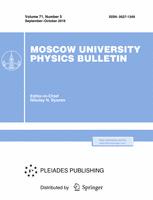A model describing the form of the angular distributions of particles emitted from a single crystal in the direction of the crystallographic axes is developed. The interaction potential of the particles with the crystal was chosen in the form of the sum of the interaction potentials with neighboring chains, and therefore had an axially nonsymmetrical form. The effect of the lifetime of the composite nucleus on the shape of the angular distribution of the nuclear - reaction products is investigated with in the framework of this model. It is found that the form of the angular distribution depends both on the value of the displacem e n t during the lifetime of the composite nucleus and on the direction of the displacement of the composite nucleus from the lattice point of a lattice in a plane perpendicular to the specified crystallographic axis. In particular it is shown that for certain orientations and for large values of the displacements (υ⊥τ~0,1 nm) of the composite nucleus the minimum in the angular distribution of the particles and of the reaction products may turn into a maximum. In addition to this there are integral characteristics of the angular distributions which for high sensitivity to the value of the displacement depend slightly on the orientation of the displacement of the composite nucleus.
НИИЯФ



